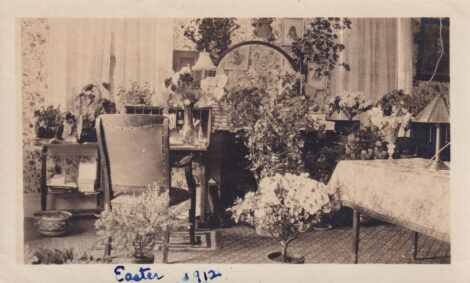The real Johnny Appleseed
- An etching of John Chapman (Johnny Appleseed) from Harper’s New Monthly Magazine in 1871. (Photo provided — Ohio Historical Society, Robert Price Collection)
- Memorial gravesite at Johnny Appleseed Park in Fort Wayne, Indiana. (Photo provided — North Carolina Central University School of Library and Information Services)

An etching of John Chapman (Johnny Appleseed) from Harper’s New Monthly Magazine in 1871. (Photo provided — Ohio Historical Society, Robert Price Collection)
There’s little in life more pleasing than biting into a fresh, crisp, juicy, mouth-watering, slightly sweet, slightly tart apple. And what could be healthier? Apples contain vitamins C and A, antioxidants, potassium, pectin, fiber, and no cholesterol. They can be eaten fresh, baked, or stewed. They can be juiced or turned into cider; made into sauce, butter, jelly, vinegar, and wine; or cooked into pies, crisps, crumbles, cakes, doughnuts, even meat dishes. They make delightful confections when coated with candy (sugar syrup), caramel, or toffee and nuts, too.
Apples have been associated with temptation (the Garden of Eden), love (in Greek mythology, Gaia, or Mother Earth, presented a tree with golden apples to Zeus and Hera on their wedding day), health (an apple a day keeps the doctor away), praise (the apple of my eye), the nation (as American as apple pie), nature (Sir Isaac Newton discovered the laws of gravity and motion when watching an apple fall to the ground), promise (apples are eaten at the Jewish New Year, Rosh Hashanah, as a symbol of the sweetness and freshness of the coming year) and legend (Johnny Appleseed).
Like most of the pioneers, Jonathan Chapman (1774-1845), the American frontiersman behind the Johnny Appleseed legend, was a rugged, fearless individualist. But unlike many, he was also a gentle, peaceful, and charitable humanitarian, most-often described as a scraggly skeleton of a man who traveled primarily by water in a birch bark canoe, never rode a horse when traveling by land, was always barefoot, even in snow, and wore bartered clothing. He always carried a tin pan or water dipper, which he most likely kept in or tied to his pack, although there are accounts of him wearing it on his head in place of a hat.
He was close to nature, didn’t eat meat, never carried a gun, and revered and respected all animals, wild and domestic. Legend has it that he was able to talk to them, that he befriended them, and that a wolf that he’d freed from a trap was often seen walking with him.
Chapman lived in harmony with the Native Americans, studying their customs and learning to speak many of their languages. He was welcome in several native villages at a time when fear and hostilities between conflicting races and cultures often resulted in violence.

Memorial gravesite at Johnny Appleseed Park in Fort Wayne, Indiana. (Photo provided — North Carolina Central University School of Library and Information Services)
By his own account, Jonathan Chapman was a missionary who preached the teachings of Emanuel Swedenborg and freely shared his library of religious books and journals with others. There are Swedenborgian churches in the U.S. today (swedenborg.org), rooted in his missionary work.
But Chapman was also a man of vision, a businessman and learned nurseryman who had planted apple orchards in western New York and Pennsylvania. So, when the Northwest Territory was opened for settlement, he set out across the Allegheny wilderness knowing that the pioneers would follow; that they would come alone and in wagon trains to settle what would become Ohio, Indiana, Illinois, and Michigan.
He had a plan. And a mission. He would get there first.
The real Johnny Appleseed didn’t scatter seed wildly or randomly here and there, as is commonly believed. In actuality, he acquired hundreds of tracts of rich, fertile land through congressional land grants, which he carefully and methodically cleared before planting. Then he put fences up around his young orchards, to keep deer and other stray animals out.
Chapman watchfully tended his trees; then sold and traded apples and saplings, charging buyers according to what they could afford. If settlers seeking nursery trees had nothing, he would barter for provisions, meals, or clothing. Sometimes he would trade for an old horse that would otherwise be killed or mistreated.
In his lifetime, the pioneer horticulturalist cleared more than a thousand acres of wilderness land and planted millions of apple trees. It’s probable that many of his seedling trees were taken further west by pioneers traveling the Oregon Trail.
He planted medicinal herbs too, and freely offered them to settlers and natives alike. Some believe this is how fennel — used for indigestion, congestion, cough, and as a stimulant and eye wash — came to be nicknamed “Johnny weed.”
Although he lived quite humbly, Jonathan Chapman was, by all accounts, a prosperous entrepreneur and real estate developer, who sold not only trees, but also tracts of orchard and tillable land. He started with nothing and managed, in his lifetime, to accumulate more than 1,200 acres of prime real estate. He also owned and operated successful tree nurseries in Pennsylvania, Ohio, and Indiana.
It’s interesting to note that until the 1930s, apples were seldom grown for eating. Apples harvested from Chapman’s trees were used in the production of alcoholic beverages — hard cider, applejack and apple brandy. Settlers found it much easier to make cider than corn liquor. And they preferred the taste. Prohibition forced the apple industry to change.
None of the many varieties of delicious eating and cooking apples produced and marketed today are cultivated from seed. The fact is, apple trees grown from seed bear little similarity to their parent trees. And apples cultivated from seed are often unpalatable.





